Last night I wrote an article that explained how you can make a knife without forging. Tonight I will try to explain how to use that knife for stabbing attacks to the greatest effect.
This video shows the reality of defending against a surprise knife attack:
Red Stuff
First off, let’s get realistic here, if you intend to use a knife to defend yourself (or to sneak attack and quietly take out that sentry if you’re all Special Forces /ninja sneaky enough to pull that off), there is going to be blood. It’s quite possible there will be a LOT of blood, depending on point of entry.
Anatomy and Physiology
Now I’m going to get all medical here and tell you that regardless of what causes it, death occurs by hypoxia. Hypoxia is the lack of oxygen to the cells of your body. Without oxygen unconsciousness occurs, followed by death.
The nerve connection
If someone dies from a blow to the head, most likely that blow damaged a part of the brain that controls the nerves involved in respiration (breathing) and/or circulation (blood flow through the body).
A blow to the head affecting respiration and/or circulation will cause death. Those are the two processes that distribute oxygen to the cells throughout the body.
Likewise, a bleeding wound that results in an amount of blood loss sufficient to deprive the cells of oxygen will result in unconsciousness and death.
This amount of blood varies dependent on the size of the person. There is no set amount of blood capacity, nor is there an average amount.
Blood capacity
Blood capacity is estimated to be approximately seven percent of body weight. So a 200-pound (91kg) human being has a capacity of about 14 pounds (6kg) of blood by weight.
Seeing as one pint of blood weighs about 1 pound (0.45kg), this translates to 14 pints (6.5 L) of blood for a 200-pound person.
Generally, a person can lose up to about fifteen percent of their blood, and have no serious ill effects. Once blood loss hits the forty percent mark, they are probably going to die if they don’t receive blood NOW.
Forty percent of 14 pints (6.5L) is 5.6 pints (2.6L), almost 3 quarts (2.85L). That’s a lot of liquid spilled everywhere.
Hypoxia via exsanguination
When a person dies from blood loss it is most commonly referred to as “bleeding out”, but the medical terminology for bleeding to death is exsanguination.
Now let’s put all of this together, a bleeding wound resulting in exsanguination causes death by hypoxia. Simple, but how can YOU cause that?
Get to the Point Already
Now that I have thoroughly bored you with the details of death by means of exsanguination, let’s look at some ways to cause it with a knife.
Generally, any device that is intended to be handheld and kill a human being is designed to make a hole to let blood out. A gun and a knife are the two most common devices for causing death by the letting of blood.
Today, we will explore the seven best places on the human body to strike with a knife in order to cause exsanguination.
We won’t go into detail about how to get the knife to that specific area, that’s up to you (or another article). We will just discuss the area and what anatomy we are accessing.
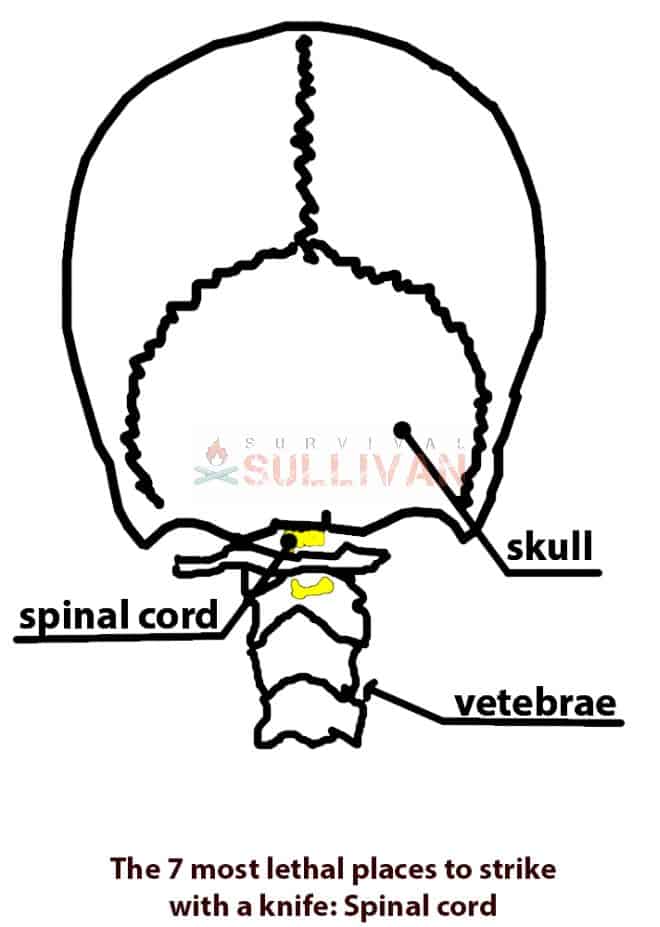
ONE-Stabbing the back of the neck at the base of the skull. The intended goal of striking this area with a knife is to sever the spinal cord/brain stem. Once the spinal cord is severed, all body function ceases.
This may seem to cause immediate death, as it will leave the person completely incapacitated. Unable to speak or anything, death will follow very shortly afterward. This type of knife injury will produce virtually instant death.
Sounds simple enough, yes? Well, actually, it’s more difficult than it sounds. Oh sure, in the movies the hero grasps the bad guy by the forehead and shoves a knife or ice pick into the bad guy’s neck or skull, and wiggles it around and that’s it, bad guy is dead. Let’s take a look at reality.
The spinal cord is encased within the vertebrae (bones that make up the spinal column). Between these vertebrae are the intervertebral discs.
These discs are tough, spongy material that cushions the joint between the vertebrae. So when you insert the knife, you have to cut BETWEEN the vertebrae and cut through the disc in order to get to the spinal cord.
To do it, hold the knife with the blade held flat and the sharp edge towards the spine.
Stab deeply and firmly into the back of the neck, with the blade point angled toward the front center, then firmly yank the knife towards the spine.
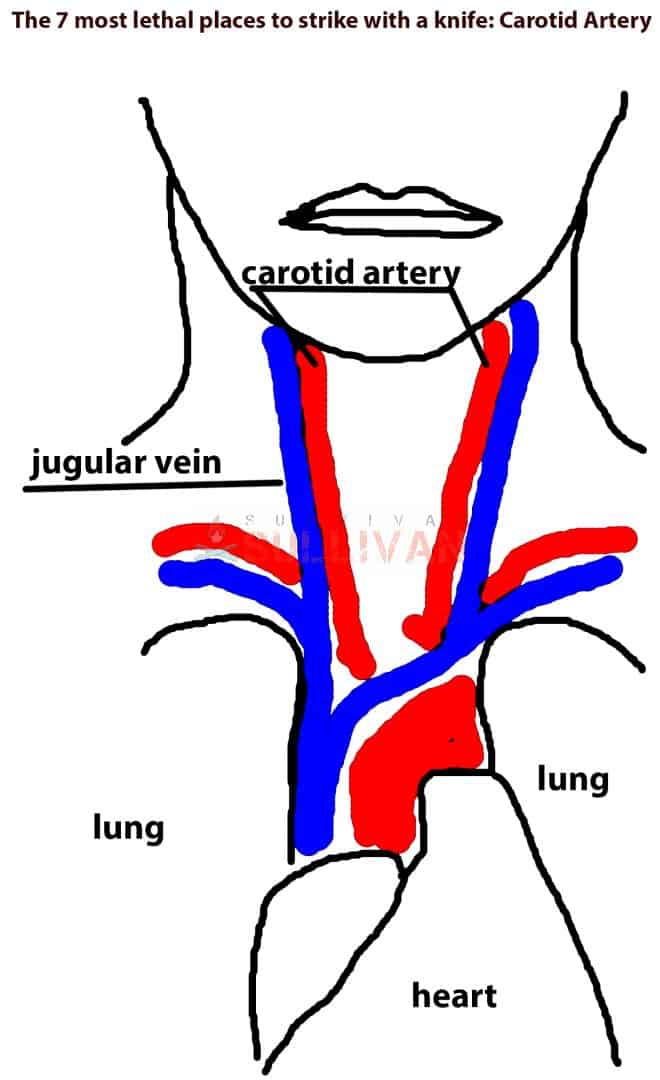
TWO– Many of you are hunters, and probably have cut a deer’s throat to hang it and bleed it to help get the game taste from the meat, so you know just how tough that cartilage in the throat is.
Due to the toughness of that cartilage in the throat, your knife must be extremely sharp to cut deeply enough to sever the carotid artery. So making that happen with a quick slash isn’t likely (I don’t care what the movies show).
Because of this, rather than trying to slash the throat through that cartilage, it is better to stab straight into the neck to the side of the larynx (AKA Adam’s apple/voice box).
With the blade flat and the cutting edge facing away from the larynx, thrust the knife in with the point angled towards the center back of the neck (this ensures you are behind the carotid artery and jugular vein).
Now yank the blade sideways, away from the larynx. If you have a really sharp knife, it should exit the neck and cleanly sever both the carotid artery and the jugular vein.
You always see movies talk about cutting the jugular; well, the jugular is a vein and is low-pressure. To cause a rapid loss of blood pressure, you want to hit the arteries.
In this case, the carotid artery is the target. The carotid artery supplies blood to the brain, and once it is severed the brain will be dead shortly after.
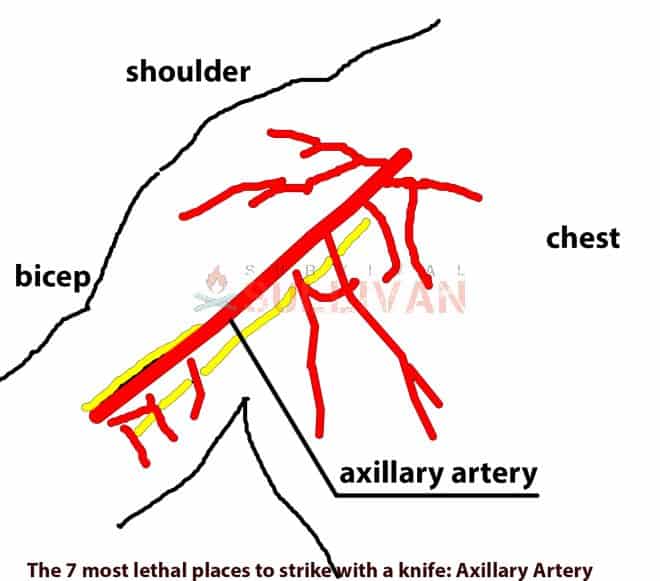
THREE– The next target we will look at is the armpit. How many times have you ever considered that as a target? Never?
Well, if you are fighting with someone, chances are they never considered their armpit a target either and so they will not be trying to defend it.
Inside the armpit is a large artery called the Axillary artery. This artery supplies blood to the arm and extremities (fingers). It is so close to the heart, if it is severed, blood will come a spurtin’.
The Axillary artery is not very deep at the armpit, so it is fairly easy to access it. The only concern would be clothing. Is your attacker wearing a thick, heavy coat? If so, then you may have difficulty getting through all of the material.
But if it is warmer weather, and they are only wearing a t-shirt or other light clothing then consider the Axillary artery a target.
To access the artery, thrust upwards into the armpit with the edge of the blade facing back towards you then yank out towards you.
This should sever the artery and shortly render your attacker out of commission.
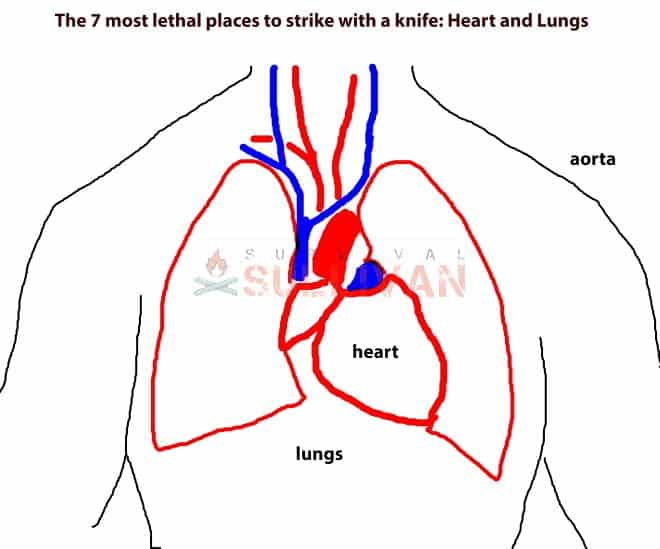
FOUR-Any deer hunter knows that when you shoot a deer, you aim for the heart and lungs. The reason why is that even if you do not get a direct hit on the heart, the lungs hold nearly one-tenth of the total volume of blood in your body.
There are also a few large arteries that deliver blood to the lungs. A knife strike to the heart can cause rapid or even instant death.
Wounding the lungs causes them to fill with blood, and in effect, the victim drowns in their own blood.
When President Ronald Regan was shot, he was hit in one of his lungs with a .22. He nearly died, even with excellent medical care because his lungs were filling with blood.
If the lungs fill with any fluid they cannot perform their function of gas exchange for respiration, i.e. you don’t get any oxygen to the cells, and you die…
By holding the knife blade flat so that it will slide easily between the ribs, you can enter the lungs easily.
When someone has been stabbed in the lungs they cannot yell or scream in warning to others. If you are trying to take out a sentry, the lungs make a good primary target to allow you to set up a second strike.

FIVE– The liver is an organ located on the right side, front of the body. It holds blood in reserve and acts as a filter. It is also an excellent target for a knife attack.
As with a lung attack, hold the blade flat so that it will go between the ribs. Going between the second and third, or third and fourth ribs will most likely give a direct hit to the liver. Wounds to the liver are fatal if not immediately treated.
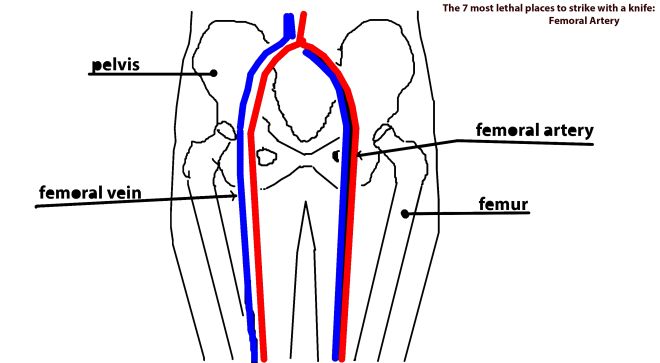
SIX– The femoral artery is a major artery that goes through the pelvic region and down the legs. This artery can be accessed by stabbing into the groin area in the crook of the leg, and cutting down.
There will be rapid blood loss with this injury if the artery is solidly struck. Death is inevitable without proper and rapid medical attention.
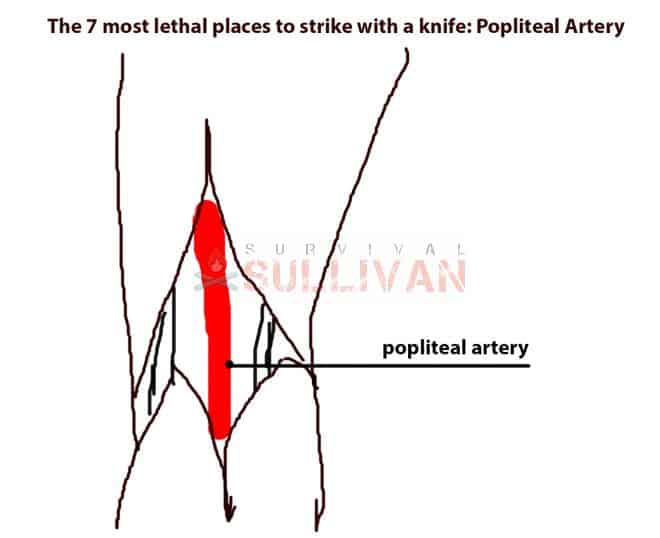
SEVEN– The Popliteal artery is an extension of the femoral artery and can be easily accessed by stabbing into the back of the knee. This artery is very close to the surface and will afford rapid blood loss if cut.
Secrets of Knife Fighting
Knife fighting is not a fight, and it is not a duel. It is a life-or-death situation. If you are involved in one, there are four possible results.
You could die, both you and your opponent could die, you could live but be seriously injured or you could win with minor injuries.
Three out of four of these are disastrous, and the last one might not be pleasant. Therefore, the first secret of knife fighting is to avoid it whenever possible.
Concentrate all your efforts on running away when practical. If chased, you choose the location best suited for your defensive stand and be sure to save enough energy for the fight.
Most martial arts styles of knife fighting teach counters to various knife attacks. For each attack, there is a block or disarming technique. And when you are sparring with others in that class, guess which attacks they will be using: those they (and you) have learned to counter.
In the real world, your attacker will probably not be trained in the same style you have been, so his attacks will be different than you are used to. Or worse, he will have survived a number of knife fights through unrelenting ferocity
The second secret is to expect (and practice against) a flurry of slashes and stabs once you are comfortable defending against single techniques.
In anyone’s hands, a knife is dangerous to you, and you probably don’t know what training or experience your attacker has. Unless they are obviously reacting out of rage, it is best to assume “a lot”.
Thus, the third secret is to always look for advantages; ways to “break the rules”. This could be an impromptu way of protecting yourself from his blade, such as wrapping a leather jacket around your blocking arm.
Or a way of blocking or inflicting damage at a greater range, such as a walking stick, collapsing baton, or belt with a heavy or sharp buckle. Always keep an eye on your environment, looking for what you can turn to your advantage.
A small, very bright flashlight can be one of the more important things you can bring to a knife fight. Shone in your opponent’s eyes, he could be effectively blinded for a few seconds (particularly if it is dim lighting conditions).
Armor is another helpful item. For centuries, the classic chain mail shirt has been protecting against bladed weapons. Butted links are not effective; they will open up under the force of a stab. You want small, riveted or welded rings.
Finding good chain mail might be a problem these days and wearing it under your clothing might be annoying. Fortunately, there have been significant advancements in Kevlar and other soft stab-resistant vests.
Another secret is that after winning a knife fight, often it is not over yet. If the justice system is still in effect, you will need to be able to show that you did not use “unreasonable” force.
Be aware that often, in the eyes of law enforcement, “any” force is unreasonable (see this article on legal/moral use of force – make no mistake, any use of a knife is considered lethal force).
Thus, be careful if your style has disarming techniques followed by fatal ones. It might be a hard sell that after disarming your attacker, you then killed him.
Be aware of the laws of your location, and select your weapons and techniques to stay within those laws to the degree practical.
If the SHTF and the situation is WROL (Without Rule of Law) then you may not have to deal with law enforcement, but you might still have to deal with friends, family, or gang members of the foiled attacker.
The converse is also true; the knife fight is not over just because you think you have won. People are different and a wound that disables one person may not disable another. Some people are sneaky and “play possum” to get you to lower your defenses.
If a person is standing, they are still a danger. If they are on the ground and still armed, they are still a danger. If they are disarmed yet can still move effectively, they are still a danger and may have another weapon.
Only a person who is disarmed and cannot move (or at least cannot move effectively) can be considered no longer a threat.
In case you have to turn your back on your defeated opponent or attend to other tasks in the area, it would be wise to carry a few “flexi-cuffs” or large, heavy-duty zip-ties.
This will allow you to immobilize him easily and fairly reliably. Although less convenient, duct tape can also be used. Still, be aware of him, as there are tools and techniques to escape such restraints. The best is to get away.
Last Jab
Be aware that if you use this information you could find yourself in deep trouble with the courts, depending on the laws in your area.
For an attacker coming after you with a knife, this is where he will be aiming to harm you. This article can help make you aware of the spots to protect in such an attack on your person, as they can be fatal.

Eric Eichenberger is an avid outdoorsman, skilled marksman, and former certified range officer and instructor with nearly 40 years experience handling and repairing firearms.
A skilled craftsman with a strong love for working with his hands, Eric spent 20 years as a carpenter and custom woodworker in high end homes. As a gold and silversmith he has created hundreds of pieces of jewelry over the years using the lost wax casting method.
The grandson of humble country folk, he was raised with the “do it yourself” mentality and so is accustomed to coming up with unique solutions to problems utilizing materials at hand.

The first kind,you don’t have to cut through the disk. Vertebrae disk are anterior to the back of the neck only going through the vertebrae ligaments and in between them would be necessary.
This is great, planning to try some of these out onto myself.
Same
“this is great, planning to try some of these out ONTO myself.”
Uhmmmmm you’re gonna stab yourself?
LOl!!!
Not a single mention of the wonderfully easy to reach “Kidneys”. Covered in nerves, vulnerable to even a ladies, long hat pin. When puncturing the surface of the kidney, a searing pain, will usually cause unconscious instantly. In a rear “sneak”, attack… A quick jab to a kidney will render the target, unconscious without much effort or noise. For those who have had a kidney stone, you will understand.
I saw the liver picture on google and I was like “what meme is this I don’t understand then I realised
It seems like it would be easier to get to the liver if you’re going up from below the rib, just bypass them altogether. And if you have a long enough knife, like a bayonet or KABAR/combat knife, you could maybe hit the lungs too.
My thoughts exactly
1/3 of your blood, every heartbeat, travels through your kidneys…of course that would be VERY close combat. You failed to mention how close the kidney/descending aorta/ liver/diaphragm/lung is.
Ok I found this page because I was watching the Borne Supremacy and there is a scene where a guy gets stabbed in the front torso and after a slight grunt falls down and die instantly so it didn’t seem logical that this could be.
In one of my novels I use the arm pit- as the kill zone-
This is a great resource for a fiction novel I am writing.
Lol, all these people saying it’s for books.
I am also starting to work on a book, this gave me the information I needed to give the main antagonist a realistic back story.
Thanks guys!
Man I hope I never get in a knife fight!
Same, but if it does happen i can now protect myself.
When I was in the Army in 1972 they taught us in the kidneys, side of neck then thrust forward to cut throat. Now that was with a bayonet.
One thing to remember, your legs are longer than your opponent’s arms. Learn low kicks as your opponent would have to bend over somewhat to stick your legs. That would make them an easier target. Number one target should be the knees, hit then hit the other knee.
This is definitely one of the better written articles on self defense with a knife. Well done sir. I learned a few things.